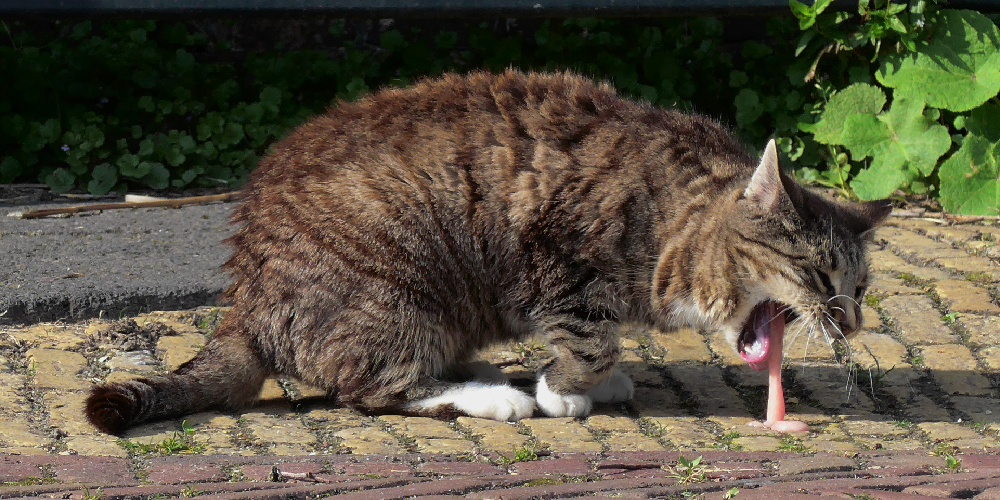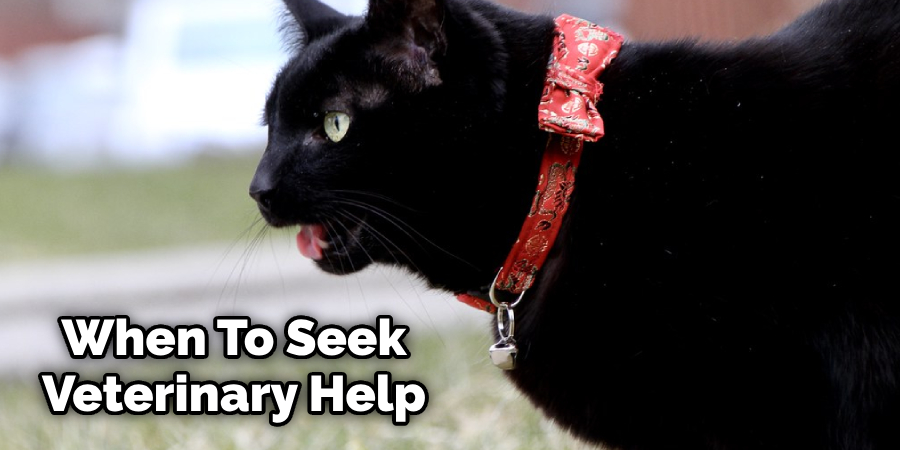Cats may vomit white foam due to reasons such as hairballs, dietary changes, or an upset stomach. Cats occasionally vomit white foam, often due to hairballs, which are formed when cats groom themselves and swallow hair that accumulates in their stomach.
Another reason for vomiting white foam can be a sudden change in their diet, causing an upset stomach. This can be caused by introducing new food, consuming spoiled food, or eating too quickly. Additionally, certain medical conditions like gastritis or gastric ulcers can lead to vomiting white foam.
It is important to monitor your cat’s behavior and consult a veterinarian if vomiting persists or is accompanied by other symptoms concerning it. Understanding the underlying cause can help prevent further vomiting episodes and ensure the well-being of your feline companion.

Understanding Cat Vomiting
What Is Cat Vomiting?
Cat vomiting is a common occurrence that can be caused by various factors, some of which are considered normal, while others may indicate an underlying health issue. Vomiting is the forceful expulsion of stomach contents through the mouth, usually accompanied by retching and abdominal contractions. Understanding the difference between normal and abnormal vomiting in cats is essential to ensure proper care and prompt attention when necessary.
Normal vs. abnormal Vomiting
| Normal Vomiting | Abnormal Vomiting |
|---|---|
|
|
Understanding whether your cat’s vomiting is normal or abnormal is crucial for their well-being. Normal vomiting is occasional, typically occurring to clear hairballs or ingested grass. There are no additional symptoms, and your cat maintains a healthy appetite with no signs of weight loss or dehydration.
On the other hand, abnormal vomiting is characterized by frequency or chronicity. The vomit may contain white foam, bile, or even blood, and other concerning symptoms such as lethargy, weakness, or fever may be present. Loss of appetite, weight loss, excessive thirst, and gastrointestinal issues like diarrhea or constipation are possible indicators of abnormal vomiting in cats.
If you notice any abnormal vomiting patterns or concerning symptoms, it is important to consult your veterinarian for a proper diagnosis and treatment plan. Prompt attention to abnormal vomiting can help prevent complications and ensure your furry friend receives the necessary care.
Causes Of White Foam Vomiting
Vomiting white foam in cats can be caused by several issues, such as hairballs, stomach inflammation, or gastrointestinal problems. It is important to monitor your cat’s behavior and consult with a veterinarian for a proper diagnosis and treatment.
Hairballs And Excessive Grooming
One of the most common causes of white foam vomit in cats is hairballs and excessive grooming. Cats are known for their meticulous grooming habits, constantly licking their fur to keep it clean and well-groomed. However, when cats groom themselves, they inevitably ingest a significant amount of hair. This hair can accumulate in their stomachs and form hairballs, which can cause irritation and discomfort.
Gastrointestinal Issues
Gastrointestinal issues can also contribute to white foam vomiting in cats. These issues include conditions such as gastritis, stomach lining inflammation, gastroenteritis, and inflammation of the stomach and intestines. Any irritation or inflammation in the digestive tract can lead to vomiting, including expulsing white foam.
Dietary Factors
Dietary factors can play a role in causing white foam vomiting in cats. It’s possible that a sudden change in diet or the consumption of an unsuitable or contaminated food can lead to gastrointestinal upset. Cats can have sensitive stomachs, and any disruption in their regular diet can cause vomiting, including regurgitating white foam.
Toxic Substances
Cats are curious creatures, and their natural curiosity can sometimes lead them to ingest toxic substances. Certain household plants, cleaning products, medications, and chemicals can harm cats if ingested. The ingestion of toxic substances can result in various symptoms, including vomiting white foam.
When To Seek Veterinary Help
If your cat is vomiting white foam, it may be a sign of a more serious issue. It is important to seek veterinary help to determine the cause and provide appropriate treatment for your pet.
Persistent Or Recurring Vomiting
Persistent or recurring vomiting is a serious concern for cat owners and should prompt immediate veterinary attention. While occasional vomiting can be normal for cats, especially if they have consumed something indigestible or if they have a sensitive stomach, persistent or recurring vomiting indicates an underlying issue that needs to be addressed. If your cat is vomiting white foam repeatedly over 24 hours or if the vomiting continues for several days, it is essential to seek veterinary help to determine the cause and prevent further complications.
Other Accompanying Symptoms
In addition to white foam vomiting, other accompanying symptoms can indicate a more significant problem affecting your cat’s health. If your feline friend is experiencing any of the following symptoms alongside the vomiting, it is crucial to seek veterinary help promptly:
- Loss of appetite
- Weight loss
- Lethargy or lack of energy
- Diarrhea
- Abdominal pain or discomfort
- Bloody or tarry stools
- Dehydration
- Changes in behavior or personality
These symptoms could indicate various conditions such as gastrointestinal blockage, kidney disease, liver problems, inflammatory bowel disease, or other underlying health issues that require proper medical attention. It is essential to observe your cat closely and provide as much detailed information as possible to your veterinarian to aid in accurate diagnosis and treatment.
Prevention And Home Care
While veterinary care is crucial for diagnosing and treating the cause of white foam vomiting, there are some preventative measures and at-home care steps you can take to help your cat before and after your visit to the veterinarian.
- Ensure your cat’s diet is well-balanced and appropriate for their age and health condition. High-quality, commercially available cat food that meets all their nutritional needs is recommended.
- Avoid sudden changes in your cat’s diet, which can cause digestive upset. If a dietary change is necessary, gradually transition your cat by mixing the new food with the old food over a period of several days.
- Provide fresh water at all times to keep your cat hydrated.
- Minimize stress in your cat’s environment, as stress can contribute to gastrointestinal upset. Provide a calm and comfortable space for your cat to relax.
- Keep harmful substances, including toxic plants, chemicals, and human medications, out of your cat’s reach.
- Regularly groom your cat to prevent them from ingesting excessive hair when they self-groom, which can lead to hairball-related vomiting.
- Follow your veterinarian’s advice regarding any prescribed medications, including proper dosing and administration.
Remember that home care can only provide temporary relief and should not replace a thorough examination by a veterinarian. It is always best to consult with a veterinary professional to address white foam vomiting and its underlying cause effectively.

Frequently Asked Questions Of Why Is My Cat Vomiting White Foam
What Should I Do If My Cat Is Throwing Up White Foam?
If your cat throws up white foam, it could indicate an upset stomach. Monitor their behavior and check for any other symptoms like diarrhea or loss of appetite. If the vomiting continues or your cat appears unwell, it is best to consult a veterinarian for appropriate diagnosis and treatment.
When Should I Be Concerned About My Cat Throwing Up?
Be concerned if your cat vomits frequently, has blood in the vomit, seems lethargic, loses appetite or shows signs of distress. Seek veterinary attention.
What Can I Give My Cat For Vomiting?
You can give your cat a small amount of plain canned pumpkin or a bland diet of boiled chicken and rice to help with vomiting.
What Does It Mean When You Throw Up White Foamy Stuff?
Throwing up white foamy stuff is often an indication of stomach acid. It could be due to acid reflux, gastritis, or excessive vomiting. Contact a healthcare professional if symptoms persist.
Conclusion
Understanding why your cat is vomiting white foam is crucial for their health and well-being. While occasional episodes may be harmless, frequent occurrences could indicate an underlying issue that requires veterinary attention. Remember to observe any accompanying symptoms and changes in behavior, as these can provide valuable clues.
Consulting a professional is essential to provide the appropriate care and treatment for your furry friend.

